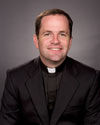Please pray for vocations
Eucharistic Adoration tonight, 7-8 pm, SAA Church. “you could not keep watch with me for one hour?” (Mt 26:40).
---------------------------------------------------
Here are some recent questions and comments made by bloggers regarding religious life and vocations:
1) Anon:
The clothing priests wear clearly defines their vocation, but spotting a nun can be much more challenging when they are not wearing their traditional habit. I saw several nuns at the Pope’s mass, but not as many as I anticipated and the only way I knew they were nuns was because of their clothing. When nuns attend a special mass, such as one celebrated by the Pope, do they wear any specific or special vestments?
FG:
No, they continue to wear their usual attire, whether that consists of a habit or not. Also, you might have seen a group of men at the Mass who were wearing black clerical garb and looking like priests. Those were seminarians (men who are studying to be priests). Unless they were participating in the Mass, they, too, remained in their usual religious attire.
2) Maryann:
Being a woman, I'm surprised it took me so long to think of us, the other half that keeps the world in balance. “Are we going to have enough nuns?” MSNBC’s Terry Wynn reported on the shortage of nuns shortly after Pope John Paul II’s death in 2005. The article questioned the new Pope’s ability to curtail the decline in the sisterhood. Terry Wynn stated, “The new Pope must address huge challenges as he takes over at the helm of an institution with 1 billion members. He must consider the growth of Islam, the relationship with other Christian denominations, the fall in priestly vocations, and charges of sexual abuse by clergy across the world.” (www.msnbc.msn.com). I suspect all three issues will be addressed by the pope during his visit to the United States.
Kenneth Jones' Index of Leading Catholic Indicators has some alarming statistics: In 1965, society enjoyed 180,000 sisters as the backbone of the education and health Systems, while in 2002, there were 75,000 sisters, a decrease of more than 50%. If the decrease in numbers is not a reason for concern, the average age of 68 should be. The index predicts that the year 2020 will be enjoying only 40,000 sisters, with only 21,000 of those under the age of 70 (www.tldm.org). I personally find this bothersome.
Some reasons for the decrease in numbers may be:- Lack of visibility - nuns are now rarely seen in education and health care institutions, both of which provided wonderful advertising for the calling. The decreased visibility and exposure to nuns presents a challenge, especially to our youth. I suspect some children go through their entire adolescent life without getting to know a nun.- Vatican II’s changes - women now have more opportunities to become involved in the social and ministerial aspects of the church. I would suspect the cost of giving up the opportunity of a family becomes too large.- Society’s expectations vs. Religion’s expectations - “ is it women that see the sisterhood as having unrealistic expectations or is it the church that has unrealistic expectations of nuns? (This same question holds true for the shortage of priests.) I would suspect this question will also be with us for a while.
These are but a few of the interesting thoughts on the decreasing number of nuns, a complicated problem that parallels our shortage of priests.
FG:
Interesting thoughts, indeed, but please remember my post from December 6, “More young women are entering convents” which presented the hopeful situation of particular religious orders experiencing a surge in young vocations. Here is a portion of that post:
"...Over the past five years, Roman Catholic communities around the country have experienced a curious phenomenon: more women, most in their 20s and 30s, are trying on that veil. Convents in Nashville, Tenn.; Ann Arbor, Mich.; and New York City all admitted at least 15 entrants over the past year and fielded hundreds of inquiries. One convent is hurriedly raising funds for a new building to house the inflow, and at another a rush of new blood has lowered the median age of its 225 sisters to 36. Catholic centers at universities, including Illinois and Texas A&M, report growing numbers of women entering discernment, or the official period of considering a vocation. Career women seeking more meaning in their lives and empty-nest moms are also finding their way to convent doors...
3) Fran: Prayer for Vocations
Most High Glorious God from whom all good comes. By the power of the Holy Spirit, call more workers into your harvest to follow in the footprints of your Son, our Lord Jesus Christ, after the example of St. Francis of Assisi according to the Capuchin way of life. Give them the strength to be generous with the fit of themselves. May they see chastity as love, poverty as freedom and obedience as victory, with an apostle's heart to serve you and your people all the days of their life. Amen
- Charles de Foucald: from a leter to a young friend preparing for ordination, 1897


1 Comments:
In response to Maryann's comment about "unrealistic expectations" and the shortage of those pursuing vocations, I must point out that the shortage of those in ministry is not unique to the Catholic Church in the US. Even denominations that ordain women and permit marriage have congregations without even a part-time regular minister.
There are those who assert that changing expectations could help to alleviate the shortage. Not knowing how the shortage of priests compares to that of Protestant ministers, it's hard to know whether there'd really be that much of an impact. Even if there were an impact, changing the "unrealistic expectations" would create a whole other set of issues that may be more problematic than the shortage.
Post a Comment
<< Home